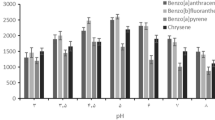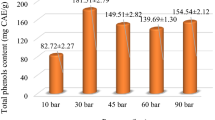Abstract
Microwave-assisted ionic liquid extraction (MAILE) has been investigated for the extraction of n-alkanes and isoprenoid hydrocarbons from petroleum source rock and the conditions for maximum yield of the analytes were determined. An aqueous solution of an ionic liquid, 1-butyl-3-methylimidazolium bromide (BmimBr), was employed as the extracting medium. The results showed that the concentration of ionic liquid, extraction time and extraction temperatures have effects on extraction yields of aliphatic hydrocarbons with optimal conditions at: 3.0 mol L−1 ionic liquid solution, 30 min and 120 °C, respectively. The extraction yields of all the n-alkanes and acyclic isoprenoid hydrocarbons were much higher using microwave-assisted ionic liquid extraction than with Soxhlet extraction and accelerated solvent extraction. There were good correlations of the diagnostic geochemical ratios calculated from the gas chromatographic (GC) data of MAILE, Soxhlet extraction and accelerated solvent extraction. The results of this study show that MAILE is an efficient and green analytical preparatory technique for geochemical evaluation of petroleum source rock.







Similar content being viewed by others
References
Bray EE, Evans ED (1961) Geochim Cosmochim Acta 22:2–15
Meyers PA (1997) Org Geochem 27:213–250
Peters KE, Snedden JW, Sulaeman A, Sarg JF, Enrico RJ (2000) AAPG Bull 84:12–44
Banerjee A, Pahari S, Jha M, Sinha AK, Jain AK, Kumar N, Thomas NJ, Misra KN, Chandra K (2002) AAPG Bull 86:433–456
Hanson AD, Ritts BD, Moldowan JM (2007) AAPG Bull 91:1273–1293
Alsharhan AS, Abd El-Gawad EA (2008) J Petrol Geol 31:191–212
Akinua A, Torto N, Ajayi TR (2008) J Supercrit Fluids 45:57–63
Monin JC, Barth D, Perrut M, Espitalie M, Durand B (1988) Org Geochem 13:1079–1086
Kramer MS, Levy M (1989) Fuel 68:702–709
Hawthorne SB, Trembley S, Moniot CL, Grabanski CB, Miller DJ (2000) J Chromatogr A 886:237–244
Chienthavorn O, Su-in P (2006) Anal Bioanal Chem 385:83–89
Du FY, Xiao XH, Li GL (2007) J Chromatogr A 1140:56–62
Hoffmann J, Nuchter M, Ondruschka B, Wasserscheid P (2003) Green Chem 5:296–299
Pancost RD, Freeman KH, Patzkowsky ME, Wavrek DA, Collister JW (1998) Org Geochem 29:1649–1662
Akaegbobi IM (2000) J Min Geol 36:175–189
Akinlua A, Jochmann MA, Laaks J, Ewert A, Schmidt TC (2011) Anal Chim Acta 691:48–55
Camel V (2000) Trends Anal Chem 19:229–248
Parera J, Santos FJ, Galceran MT (2004) J Chromatogr A 1046:19–26
Anderson JI, Ding J, Welton T, Armstrong DW (2002) J Am Chem Soc 124:14247–14254
Guolin H, Jeffrey IS, Kai Z, Xiaolan H (2012) J Anal Methods Chem 2012:1–8
Tissot BP, Welte DH (1984) Petroleum formation and occurrence. Springer, Berlin, Heidelberg, New York, Tokyo
Peters KE, Walters CC, Moldowan JM (2005) The biomarkers guide 2: biomarkers and isotopes in petroleum exploration and earth history. Cambridge University Press, Cambridge, pp 475–1155
Acknowledgments
We thank German Academic Exchange Service (DAAD) for travel Grant awarded to A. Akinlua for research visit to University of Duisburg-Essen, Germany where this study was carried out. We also thank Prof. Dr. Oliver Schmitz for allowing us to use his microwave. The assistance of Maria Madani is gratefully appreciated.
Author information
Authors and Affiliations
Corresponding author
Rights and permissions
About this article
Cite this article
Akinlua, A., Jochmann, M.A. & Schmidt, T.C. Microwave-Assisted Ionic Liquid Extraction of n-Alkanes and Isoprenoid Hydrocarbons from Petroleum Source Rock. Chromatographia 78, 1201–1209 (2015). https://doi.org/10.1007/s10337-015-2939-2
Received:
Revised:
Accepted:
Published:
Issue Date:
DOI: https://doi.org/10.1007/s10337-015-2939-2




